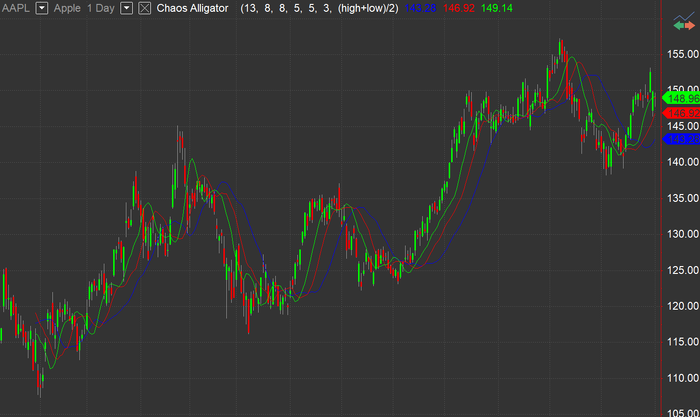Chaos Alligator: Difference between revisions
| Line 6: | Line 6: | ||
To analyze market trends and potential turning points, the Williams Alligator indicator uses smoothed moving averages set at periods based on Fibonacci numbers: 13, 8, and 5. They are Jaw, Teeth, and Lips/Mouth correspondingly. | To analyze market trends and potential turning points, the Williams Alligator indicator uses smoothed moving averages set at periods based on Fibonacci numbers: 13, 8, and 5. They are Jaw, Teeth, and Lips/Mouth correspondingly. | ||
* '''Jaw''' is a blue line that begins with the 13-bar SMMA and shifted forward by 8 bars. | * <font color="blue">'''Jaw'''</font> is a blue line that begins with the 13-bar SMMA and shifted forward by 8 bars. | ||
* '''Teeth''' are a red line that begins with the 8-bar SMMA and shifted forward by 5 bars. | * <font color="red">'''Teeth'''</font> are a red line that begins with the 8-bar SMMA and shifted forward by 5 bars. | ||
* '''Lips/Mouth''' are a green line that begins with the 5-bar SMMA and shifted forward by 3 bars. | * <font color="green">'''Lips/Mouth'''</font> are a green line that begins with the 5-bar SMMA and shifted forward by 3 bars. | ||
The Jaw of the Alligator inherently makes the slower turns, whereas the Lips/Mouth of the indicator make the faster turns.<br> | The Jaw of the Alligator inherently makes the slower turns, whereas the Lips/Mouth of the indicator make the faster turns.<br> | ||
Revision as of 16:39, 21 May 2024
Definition
Chaos Alligator indicator (or Williams Alligator) is a trend-following technical analysis tool introduced by a well-known trader and author Bill Williams. It is based on the idea that financial markets and individual securities usually trend at a lower rate than sideways ranges. The indicator was developed with the thought in mind that both institutions and individuals generally collect more profit when a market is trending strongly.
Components
To analyze market trends and potential turning points, the Williams Alligator indicator uses smoothed moving averages set at periods based on Fibonacci numbers: 13, 8, and 5. They are Jaw, Teeth, and Lips/Mouth correspondingly.
- Jaw is a blue line that begins with the 13-bar SMMA and shifted forward by 8 bars.
- Teeth are a red line that begins with the 8-bar SMMA and shifted forward by 5 bars.
- Lips/Mouth are a green line that begins with the 5-bar SMMA and shifted forward by 3 bars.
The Jaw of the Alligator inherently makes the slower turns, whereas the Lips/Mouth of the indicator make the faster turns.
These components open and close depending on their subsequent reaction to evolving trends and trading ranges alike.
How to interpret results
Plots of the Chaos Alligator can help identify the direction and strength of a trend and determine entry and exit points in the market:
- When the three lines are intertwined, the market is in a resting or consolidating phase, often referred to as the "Alligator is sleeping".
- When the lips (green line) crosses over the teeth (red line) and jaw (blue line), "the Alligator is waking up" and a new trend might be starting.
- When the lines are fanning out and moving in the same direction, it suggests a strong trend, indicating that "the Alligator is eating".
Default Inputs
Jaw = 7 by default.
JawOffset = 8 by default.
Teeth = 8 by default.
TeethOffset = 5 by default.
Lip = 5 by default.
LipOffset = 3 by default.
Value sets the formula (high+low)/2.
